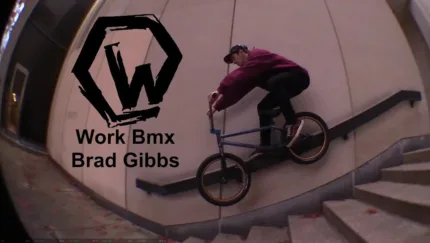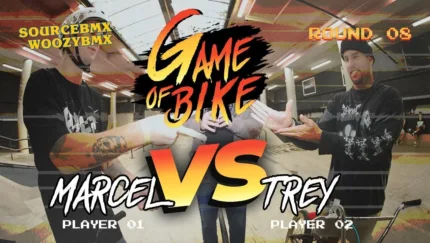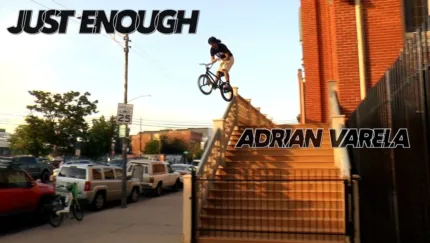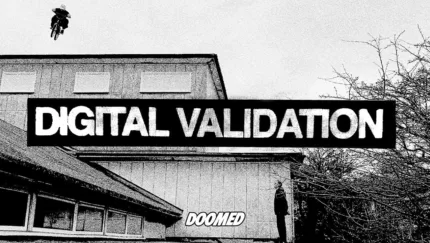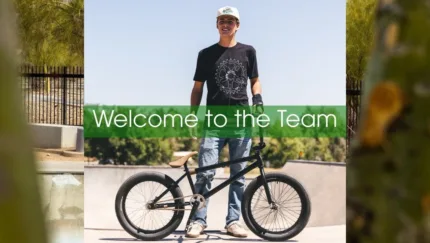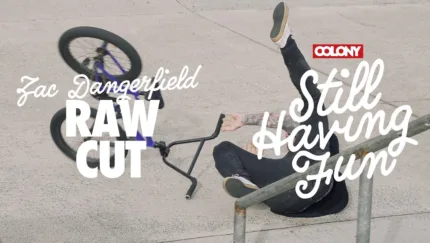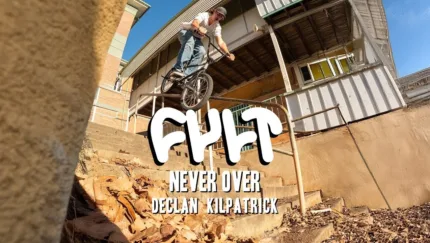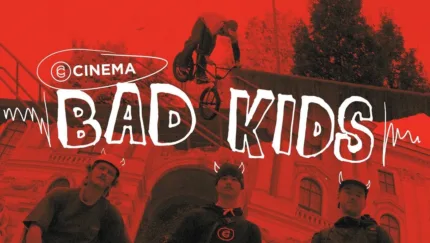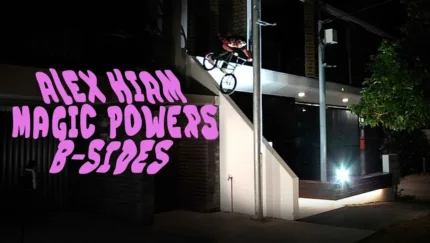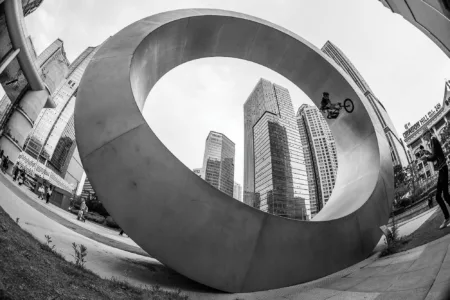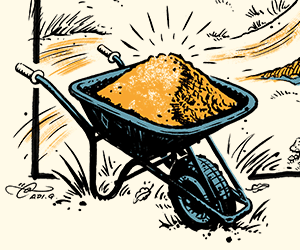
Short Frames and Street Riding - A Brief History
How that flatland influence runs deeper than you might think...
By Paul Covey & Joey Spinoza
In 1990, Mat Hoffman revolutionized the future of BMX street riding when he decided to slide a handrail in San Diego on a 1990 Haro Sport with a bash guard. At the time, the Haro Sport had a 19.5” top tube. Did Mat Hoffman care about his top tube length at the time? We really couldn’t say, but history was made and BMX changed forever because of a bike with a top tube length that by all accounts, was originally made for flatland.
That was 1990. Today, in 2017, it doesn’t seem that different.
Technical street riding boundaries are expanding rapidly, with many of those at the modern forefront of innovation advocating the latest and greatest frame technology that incorporates not only a shorter top-tube, but also an incrementally shorter rear-triangle. Universally, the set-up most riders select boils down to personal preference, however, one thing is for certain: riding a shorter frame on street is hardly a new trend. Looking back, the most primitive BMX riding took place on kid bikes that were shockingly small by today’s professional standards.


Matt Hoffand and that Haro Sport mounted San Diego handrail circa 1990, swiped from the pages of BMX Plus magazine via Snakebite.
Historically, the average BMX kid in the 80s (including Mat Hoffman) had absolutely no clue what the top-tube or chain stay lengths were on their frame. Maybe a few folks knew about that stuff in racing, but in freestyle? Not likely. Bikes simply weren’t advertised using those aspects; that information wasn’t normally made accessible. Magazine bike tests may have briefly mentioned frame dimensions, but almost no one referenced that information when making the decision to purchase a new frame. Powerhouse 1980s corporations like GT, Mongoose, and Diamond Back marketed their wares to the masses of suburban teen-agers primarily with advertisements that featured flashy bright colors, wild, bolt-on knick-knacks, and incredibly talented, often charismatic team riders who toured the country doing shows, rode in contests, and (long before web-edits ) appeared as magazine editorial content.Anyway, most of the bikes themselves were designed with the intention that they be ridden around in your parent’s driveway or possibly down the street to buy a Slurpee… certainly not on vert ramps, dirt jumps, or handrails.

Craig Campbell and that infamous mid-eighties Slough UK gap with the Mud Machine crew and a visiting Eddie Roman, riding the short Skyway Sreet Beat frame.
This all changed as the late 80s became the early 90s. Most of the western world had been affected by an economic downturn. Add that with the Super Mario Brothers keeping a new generation of potential riders purchasing power otherwise preoccupied, and you get the bulk of the established BMX industry vanishing seemingly overnight.
It was at this point that hardcore riders started to take their places as upstart company owners — who actually cared about BMX and rode the bikes they made. The early 90s were an exciting and experimental time where actual riders began to question the status quo of bike specs and quality, to innovate, and design frames more appropriately suited to handle the nature of modern BMX riding. In the early stages of innovation diffusion, growth is relatively reluctant. But be that as it may, as rider-owned innovation spread its chromoly wings, however slowly, frames and parts became so much better. Gimmicks gave way to functionality, and a few relative “standards” rose to prominent utilisation. Sounds basic now, but at the time it really was a radical shift. Eventually, even the average rider inclined to be slightly more educated and informed about frame specs and sizing. Consequently, that data has also became useful to manufacturers for marketing purposes.

Blyther brought style to the streets on his Haro Sport way before street riding was really even a thing. Boston, circa '87. Photo via the Wiz Pubs wastebasket.
Old school frame specs are often iffy, but my sources tell me the 1987 GT Pro Freestyle Tour had a top tube that averaged around 18.5 inches long and that the 1987 HARO Sport, which was known as a ramp bike, had a top tube that measured around 19.25 inches long. Notable early experimentation quickly led to longer top-tubes on frames for ramp riding, dirt jumping and street that looked more akin to late 80s BMX racing bikes than their multi-platformed freestyle predecessors. (The other major difference also being that tubing got a beefier and dropouts got thicker.) By the mid 90s, ramp/street/dirt frames like the 21 inch S&M Holmes and 21 inch Hoffman Taj were part of a new wave of longer wheel base chassis that fit larger/taller riders better, created greater leverage for bunnyhops, and were considerably more stable at high speeds. Makes sense, doesn’t it?
On the other hand, just as the lion’s share of street and ramp riders were adopting longer frames, a few noteworthy outliers continued to innovate and experiment and with shorter dimensions on their bikes: That experimentation and innovation continued to this day as back ends got shorter in parralel with street riding becoming more and more technical.
A FEW OTHER POINTS OF INTEREST...

• Bob Haro’s original Freestyler (above) was tiny and was huge part of the very early days of street riding, and Brian Blyther rode legit street spots on a Haro Sport... but we think the original ‘80s outlier may have even have been R.L. Osborn's Redline and Bully Frames.
• In 1993-1994, Bicycle Stunt gladiators Dave Mirra (RIP) and Jay Miron both destroyed everything in their paths on flatland god-tier Kevin Jones’ signature Hoffman Big Daddy frame with an 18.5 inch top tube and a 14.5 inch rear end.
• On the West Coast of California, Flatland Fugitive, Sean McKinney, (who not only has the ninja skills in the parking lot but can hit 8 ft on a vert ramp on a good day), designed the 18.5 Sabbath frame for S&M and it was incredibly well received by both the flatland and street community, with vocal praise coming from S&M rider Troy McMurray. After riding a Sabbath for a while, Troy liked it so much that he designed his signature War Pig frame to have similar aspects like a shorter front end and steeper angles. To the best of our knowledge the OG Sabbath had a 19” top tube, that reverted back to 18.75”.
Hoffman BIG DADDY. Source - BMX Museum
S&M SABBATH. Source - BMX Museum
Osicka Standard TAO. Source - BMX Museum
Standard SHAMAN. Source - BMX Museum
“Standard took the front end of Tao and combined it with the rear end of an STA, creating the Shaman, which featured a 19.5” top tube.”- Bobby Fisher
• Another swank rider who smoothly mixed flatland and street, Tennessee’s Bobby Fisher, helped Standard Bykes develop the hybrid “Shaman” frame with a 19.5 top tube. The Shaman was a mix between the popular TAO flatland frame and an STA, being one of the first bikes marketed as a flat/street option. Empire has one and that thing is a tank by today’s standards, no pun intended, but a pretty bold move for SBC at the time, whom recognized Bobby’s flatland-esque approach to street riding at the time before anyone else thought about that thing. Bobby had a section in ‘Domination’ and he was essentially a flatlander.
• One that flew under the radar a little was the WethePeople Pony that was available around 2000-2001 and had flat/street geometry. There weere few of these floating around Austin back then ridden by the likes of Cullen McMorrow and the innovative Aaron Behnke.
• Even John Heaton’s signature MacNeil frame is an early foray toward a shorter front and rear ends with a 20 inch top tube, and an accompanying shorter rear triangle at 13.5". "
"Heaton actually had a custom frame that he rode with a way shorter rear end than what was sold as the MacNeil Heaton. It was maybe as short as 12.5” but i can't be 100% sure. I do know his bike was a dream to manual though." - Brian Tunney
WTP PONY
MACNEIL HEATON
• Street pioneer Ian Morris also rode a S&M Sabbath frame prior to helping get the Federal Fraction 19" frame off the ground around 2003.
• New Jersey flatland/street rider Brian Tunney also worked with Federal to bring about that Fraction 19 inch street/flat frame. Ohio’s street shedding savant, Steven Hamilton, appeared riding on a Fraction in Road Fools 11, and eventually his own frame with similar flat/street dimensions in legendary videos like Federal’s Trafaelio, and Animal’s Can I Eat?

Ian Morris: S&M Sabbath mounted circa 1998. Photo by Ed Docherty.
"To one degree, we modelled the Fraction off of the Tao because it was too expensive and not available. To another, I wanted something that looked like my Mongoose FS-1 that I grew up riding, just a traditional double diamond BMX frame with no crazy platforms or anything. Looking back, that thing (the Mongoose) had an 18.5” top tube, which is insane to think about now. Once Hamilton got on that bike, his Tao was dying a slow death and he couldn’t afford to buy another, I stepped back and realized that Steven would sell way more bikes than I ever was. So yeah, Dean Hearne designed a cheaper knock off of a bike that I liked, Steven rode it better than anyone else, and Federal saw the writing on the wall. I’m glad his riding had and still happens." - Brian Tunney


The hugely influential Joe Cox riding a Standard TAO in Sheffield UK circa 2003. Originally published in DIG 42. Photo by Ricky Adam.
We chatted with BMX vanguards Steven Hamilton, Ben Lewis and Grant Smith (BSD), to ask about their influences and thoughts on short frame usage in BMX past, present, and future.
Steven Hamilton

Steven Hamilton, Hastings UK circa 2004, getting his noz on (long before anyone used the word 'noz'), riding the early Federal Fraction. Photo by Ed Docherty
Which riders inspired your riding style back when you started riding a short frame for Federal?
After etnies Forward the next good video I got was a mixtape my friend Ted made for me. That had the first Animal video, FBM’s All time Low and Brian Yeagle's part from Who Brought the Dicks. So these were the next guys that I was looking up to around when I got on Federal, and got to do my signature frame. I was, and still am, convinced Derrick Girard was the best.
What frame were you riding before that?
Before I got to do my own frame with Federal I rode a Federal Fraction.

Were there any influences in your riding from outside of BMX?
Oh yeah, it wasn't really about BMX at all, it was more just being radical, extreme sports, music, art and photography.
Had you seen a frame back then that you wanted Federal to imitate?
My idea for my frame was I wanted to mix the Standard Tao dimensions that I loved so much with a basic BMX bike look of a GT Interceptor which was my first favorite bike.
How does it feel to have influenced a lot of what we see in street riding today?
It feels great on one hand but on the other I don't think I get acknowledged for a lot of it and I think it's sad the amount of the companies that sponsor people who do my stuff but don't sponsor me.
BEN LEWIS

Ben Lewis and his 19" Standard STA. Liverpool UK, circa 2001. Originally printed in DIG 21. Photo by Ricky Adam
Which riders inspired your riding style?
Troy McMurray, Butcher and Will Taubin. All street innovators!
Who has influenced you to ride a smaller frame?
When I started riding I was tiny and didn't know anything about geometry. I saw Troy riding a S&M Sabbath so that's what I wanted! It just happened to be the best bike I had ever ridden! I had a Mongoose Fuzz before that so I probably lost about ten inches in wheelbase when I changed to the Sabbath! After that all I bought where flatland frames. Most of the time I would cut in the dropouts too to make them as short as possible! Hamilton was probably the next rider I saw on a short bike. He seemed to have a similar outlook (on riding) to me.
I heard you once rode a shorter custom-made Standard. How was that?
Yeah that was incredible! I had that for like 6 years it was a tank! It was a 19 inch TT but still had the regular length back end. I had to cut the thing in a lot on the dropouts! If I had known more about geometry back then, I would have ordered it shorter in the first place.
What frame were you riding before that?
I had a WeThePeople Pony after the Sabbath and then a Federal Fraction after the Standard. Originally when I got hooked up by Fit, they made me a custom 19 inch Aitken frame that I fucking loved!
Were there any influences in your riding from outside of BMX?
I always enjoyed watching any forms of movement. Anything from dancing to snowboarding could inspire a new way of riding a setup.
Do you feel like you’ve had an impact on what we see in street riding today?
I don't feel I have really. Anything I was doing was a movement that was happening all over. I always meet people who used to cut their frames in or ride flatland frames too until modern street frames caught up.
Grant Smith – BSD

Alex Donnachie on his ALVX frame, Israel 2016. Photo by Fred Murray.
What were the main factors that led to BSD making the ALVX frame?
Tech street riding is the main factor that led to making the ALVX frame, Alex rode the WZA frame with the back end slammed at 12.8" and he wanted a shorter rear end than that, we made the ALVX as short as we could go and still be able to run a 28t sprocket and 2.4" tire. Also he wanted a steeper head tube angle.
Why are more riders these days looking to try out shorter front and rear ends for street?
People like to try new things. Riders will see someone like Alex D or Benny L doing what they do on a shorter frame and think that they want to try that. Long frames are good for trails and ramps due to the stability they offer, but if you mainly ride street and you don't need that stability, then short and responsive seems like a good choice.
"We made the ALVX as short as we could go and still be able to run a 28t sprocket and 2.4" tire. Also Alex wanted a steeper head tube angle. "-Grand Smith / BSD
Where do you think frame specs are heading in the future? How far can it go?
Maybe even steeper head angles and shorter frames? Who knows. Frames with pictures of cats and dogs on them? The street frames now are becoming like flatland frames (like the Standard TAO for example). It's sort of like what happened in skateboarding in the late 1980s and early 1990s. There were different disciplines such as vert and flatland skating, vert skaters used huge weird shaped decks and flatlanders had tiny simple shaped decks. Street skating ended up evolving skateboards that were somewhere in the middle of the two due to needing the technical functionality of the flatland deck but a decent size too. Also most skate decks are the same shape these days (and have been for years). It's like how frames now have evolved into a similar look, people years ago didn't really understand geometry and would ride frames they liked the look of with all sorts of gimmicky platforms and bent tubing. Now people understand the effects of geometry they don't need all that other shit.
How much of a difference does a half inch change in the angle of the head tube, seat tube, or the length of the rear triangle actually make in the way the bike feels when you ride it?
Every little change effects the feel. A steeper head tube will make nose wheelies easier to pop up into but it will make your bike feel way more twitchy riding a ramp. As for the seat tube angle, the BSD Passenger frame has a 69 degree seat tube angle which is really mellow (standard seat tube angles are 71 degrees) meaning that it feels like there's more room in the front end of the bike relative to where the BB is positioned (where you stand!). A half inch change in the rear end length can make the difference between being able to manual or flipping off the back, interestingly I rode Zach Shaw's bike recently and it has a really long rear end, around 14.5" I think so that it's really stable on vert. Anyway that bike felt hard to get into a manual but when you were finally balancing it was so stable, you could hang right off the back and still not loop out, it's all about the leverage!
Check back here on DIG in a couple of weeks for our Short frames Productivity special feature.
Previous
Meat Sweats - etnies in Kansas City
Home from home in KC
Next
PROPS - Don't Call It A Comeback
An Interview With Props Founder Chris Rye
Related Content

















